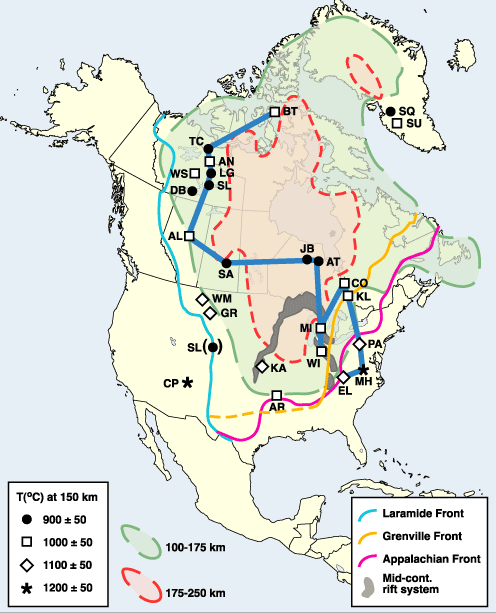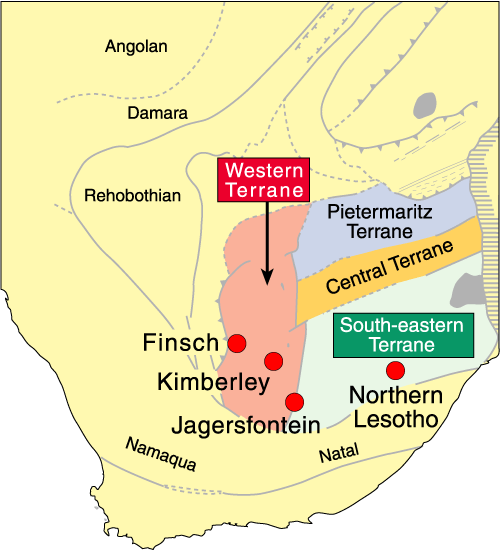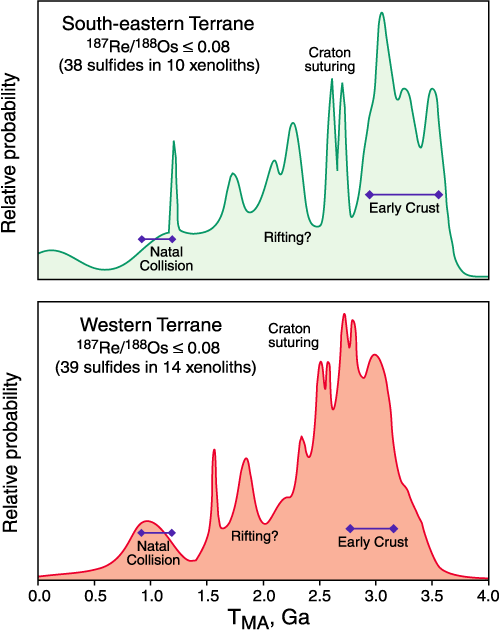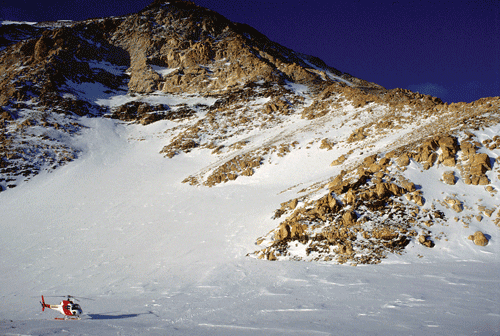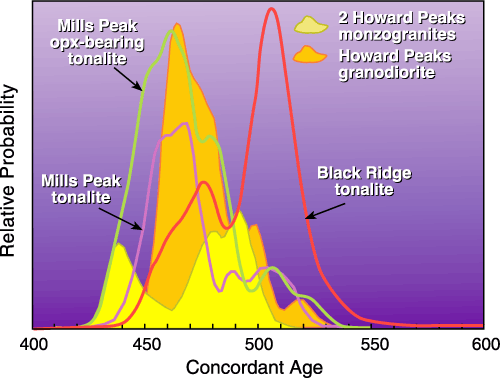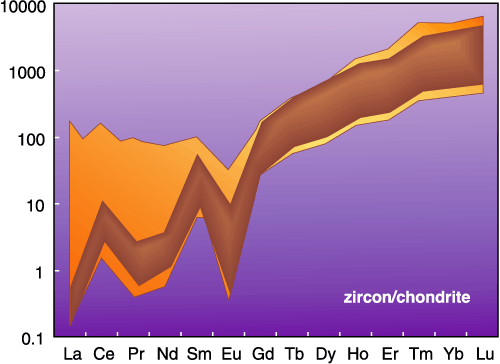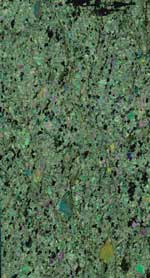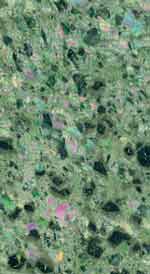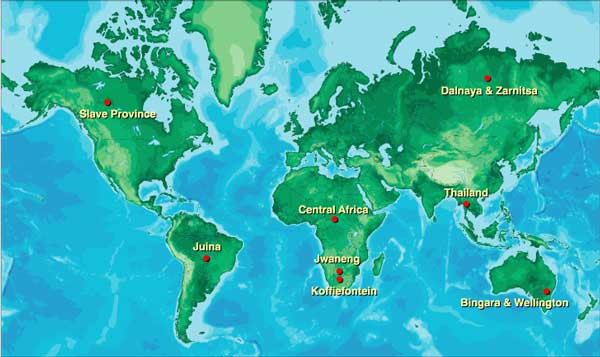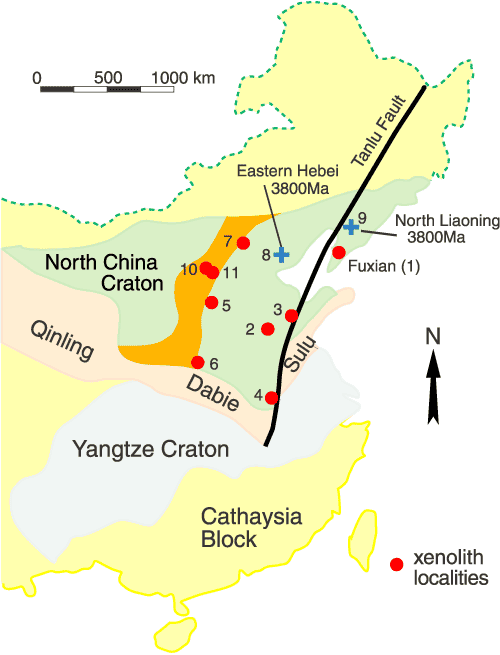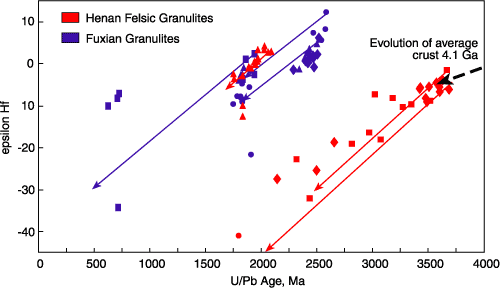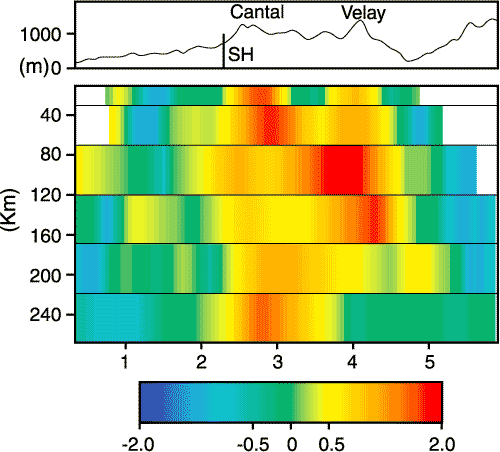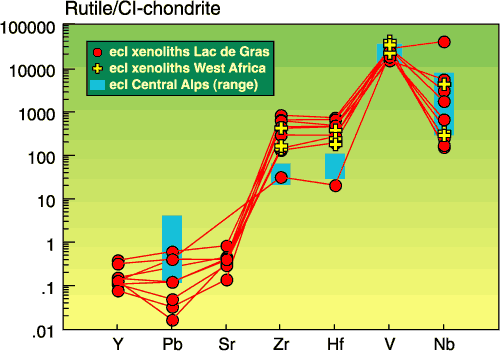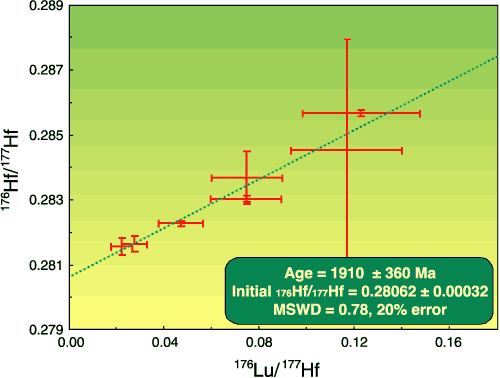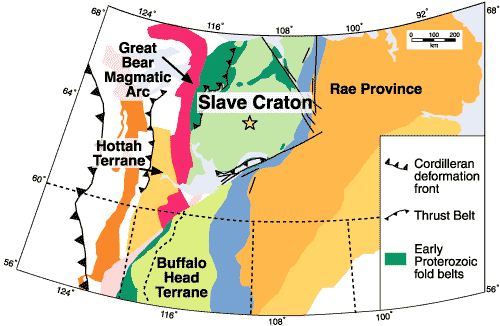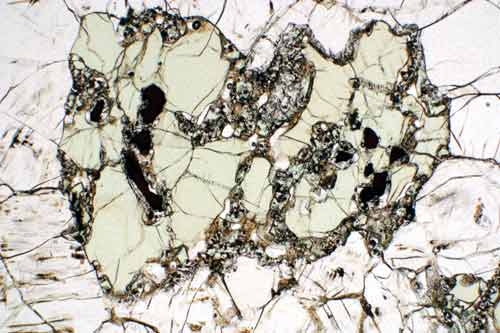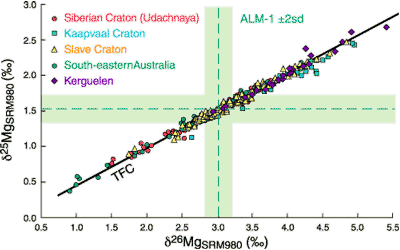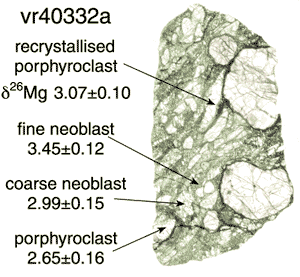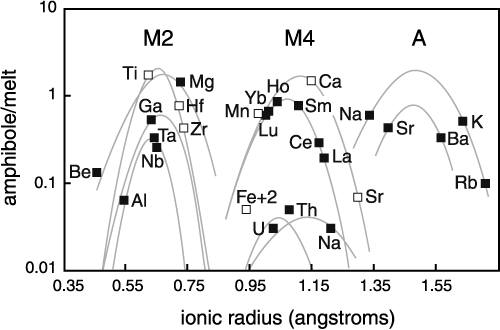Research highlights 2002 |
|
||||
| Index |
|
| Journey to the centre
of the Earth |
Gemoc’s first six years concentrated heavily on mapping the composition and architecture of the lithosphere in 4 dimensions, using mantle-derived rock samples and mineral debris brought to the surface in host magmas. Time provides the 4th dimension and is measured by the age of the host magmas. We have mapped the crust-mantle boundary and the lithosphere-asthenosphere boundary in different lithospheric sections in space and time, and have the most detailed information for the points shown. This work has made some significant conceptual discoveries (eg Publication #234) including: • Lithospheric mantle composition and thermal structure have changed with time (apparently episodically) and three major mantle types can now be recognised, reflecting major episodes of formation. Progressive reworking of early lithosphere provides a continual geochemical evolution trend towards the present. • Archean and Proterozoic mantle roots are highly buoyant; they cannot be delaminated but require mechanical disaggregation (lithospheric thinning and/or rifting) and infiltration of upwelling fertile material to be destroyed or transformed. • Phanerozoic SCLM is denser than the asthenosphere for observed thicknesses (~100 km) and can “delaminate” under stress. The availability of refined seismic tomography datasets allows us to move on to the next phase of lithosphere mapping and to investigate large-scale problems such as: • the implications of lateral variability between physical properties due to the compositional difference in lithospheric mantle domains • the nature of domain boundaries identifiable in the lithospheric mantle; these may be important pathways for mantle fluids and relevant to metallogenesis • the density variability of global lithospheric domains vertically and laterally • the tectonic histories of coupled crust and mantle lithosphere terranes, assisted by input from TerraneChron™ studies (see Research Highlights) Our aim is the compilation of a global map of Earth’s lithosphere |
| Global tomography image
at 150 km based on dataset of Ritsema (Ritsema et al., 2000. Sci. Prog,
83, 243-259). Highlighted points identify some regions where GEMOC
has most detailed petrologic and geochemical controls on the composition
and architecture of the lithospheric mantle. |
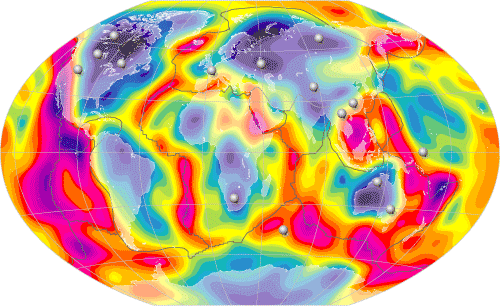
|
| Lithosphere
mapping beneath the North American Plate Figure 1. Map of N. America with contour outlines of the high-velocity lithospheric root at 100-175 km (red) and 175-250 km (green) after dataset of S. Grand. Symbols indicate temperature at 150 km (as derived from geotherms). The traverse line referred to in the text is also shown.  Figure 3. Rock-type sections ffor the Slave (Lac de Gras), Michigan ans Saskatchewan regions. |
The compositional structure of the subcontinental lithospheric mantle (SCLM) beneath the North American Plate (USA, Canada, W. Greenland) has been mapped in 3D using major- and trace-element data on Cr-pyrope garnets from ca 100 kimberlites, lamproites and lamprophyres in 26 areas (Fig. 1). A statistical classification scheme (Publication #299) allows mapping of garnet compositional populations with depth to produce SCLM sections, which show the distribution of rock types and metasomatic processes. Inversion of a garnet-olivine thermometer (Publication #222) has been used to map the variation in mean XMgolivine with depth. Analysis of seismic tomography (Fig. 1) shows that known kimberlites do not sample the thickest and most depleted part of the North American SCLM; on a continental scale, as well as the regional scale, kimberlites and related rocks tend to be concentrated near major changes in lithospheric thickness. Available SCLM samples therefore represent the thinner and modified outer parts of the continental root. SCLM composition shows broad correlations with the tectonothermal age of the crust at each locality, and strong correlations with seismic velocity at 100-175 km depths. The thickness of the depleted SCLM varies from >200 km (Paleozoic in State Line District, Mesozoic in Saskatchewan), to 120-130 km in strongly modified younger areas (Colorado Plateau, N. Montana), and to ca 60 km beneath young orogens (Appalachians). The SCLM thickness is closely related to the geotherm, as reflected in the temperature at 150 km depth (Fig. 1). Mean XMgolivine is typically 92.6-93.2 in the upper parts of the
SCLM beneath Archons, and beneath Protons with significant Archean prehistory
(Figs. 1, 2);
many Proton SCLM sections probably represent metasomatically modified
Archean SCLM. Tectons and possible “juvenile” Protons have less
magnesian SCLM even at shallow depths (eg Colorado Plateau, 91.3; Kansas,
91.2; Virginia, 90.2). The highest mean XMgolivine is found in
localities (Michigan, Hudson Bay) on the edge of the highest-velocity
part of the root, where magnesian compositions also extend to greatest
depth (Fig. 2); this suggests that the central cratonic “root” represents
the extension of this highly depleted material to depths >175 km. Figure 2. Distribution of Xmg of olivine
with depth along the traverse shown in Figure
1. Many SCLM sections are relatively homogeneous in terms of rock type distribution and XMgolivine, except for a rise in fertility and a drop in XMgolivine to asthenospheric values (≤90.5) over distances of 10-50 km toward the lithosphere-asthenosphere boundary. The transition from depleted lithosphere to asthenosphere is relatively sharp under the eastern part of the craton, and broader beneath Protons (Fig. 2); this may reflect more extensive metasomatism beneath the Protons. Several sections show marked stratification, typically with the upper layer being more depleted, and one or more sharply defined discontinuities at 120-160 km depth. In terms of trace-element depletion, the upper part of the central Slave Craton stands out dramatically from other parts of the craton (Fig. 3); this appears to reflect greater degrees of later metasomatic re-enrichment outside the Slave Province. In West Greenland, interleaving of depleted and fertile SCLM may reflect tectonic stacking, related to the development of the nearby major Proterozoic suture zone. Other cases (Lac de Gras, N. Michigan, Saskatchewan; Fig. 3) are interpreted as the result of plume subcretion beneath a depleted SCLM of moderate thickness. Synchroneity between kimberlite intrusion and basin subsidence in the latter two cases is consistent with suggestions (Kaminski and Jaupart, 2000. EPSL, 178, p.139) that plume modification of the SCLM caused the development of these major intracratonic basins. This analysis reveals strong correlations between the degree of depletion (XMgolivine), the geotherm and tectonothermal age. Depletion and lithospheric temperature are negatively correlated, and thus have mutually reinforcing effects on seismic velocity. These correlations simplify the interpretation of seismic tomography in terms of lithosphere composition and history. The central core of the North American continent has an extensive, highly depleted root that extends well below 175 km, but is poorly sampled by known kimberlites. This root is essentially continuous beneath the Early-Mid Proterozoic mobile belts of the Canadian Shield. The outer parts of the root have been modified by introduction of material from the asthenosphere in both Archean and later time, producing a belt of varying thickness in which the SCLM has a less magnesian mean composition, and tends to be thinner. The intermediate seismic velocity of Tecton areas such as the Appalachians reflects both the fertile nature of the SCLM, and moderately elevated geotherms. Areas such as the Colorado Plateau, which has a moderately fertile mantle and is currently experiencing thermally driven uplift, show anomalously low seismic velocity in the 100-175 km depth range. The present lithospheric architecture reflects an interplay between the buoyancy of Archean SCLM, its modification along rifts and mobile belts, the generation of juvenile Proterozoic and Phanerozoic SCLM, and the subcretion of plume head material. Lithospheric mapping, combined with interpretation of seismic tomography, indicates that relict Archean SCLM probably is present, at least at shallow levels, beneath much of the Proterozoic part of the N. American plate. This conclusion has important tectonic implications and is being tested by in situ Re-Os analysis of sulfides in mantle-derived xenoliths. Contacts: Bill Griffin, Sue O'Reilly, Norman PearsonFunded by: ARC, Industry, Macquarie University |
| Taking the pulse of the Earth: Lithosphere
events tracked by in situ geochronology
Figure 1. Terrane structure of the Kaapvaal Craton, showing localities sampled in this study; (after Publication #303). |
The delivery of mantle fragments to the surface by kimberlitic
and other deep-seated volcanics has allowed the mapping of compositional
domains and architecture of the lithospheric mantle and lower crustal
regions, as well as ground-truthing of geophysical datasets and modelling.
New techniques for in situ dating of mantle wall-rocks using the
Re-Os isotopic system (Publication #267) are
revealing that these peridotites contain sulfides that record many events
in the lithosphere. These range from the original depletion event(s)
that formed the lithospheric domain to subsequent episodes of fluid addition
that accompanied large-scale metasomatic transport, lithosphere reworking
and/or younger lithospheric additions. The timing pattern of such
events can also be used to test if different cratonic lithosphere domains
had common evolution histories or if they docked or separated discretely. Sulfides with high Os contents but low 187Os/188Os (gOs <1) and low Re/Os and Pt/Os ratios commonly are enclosed in primary silicates. If they have 187Re/188Os <0.08 and Pt/Os <0.5 they are inferred to represent monosulfide solid solution phases that are residual from partial melting or have crystallised from sulfide melts (ie primary; Publication #218 and Publication #292). It is these sulfides that potentially provide information on the timing of lithosphere stabilisation episodes, ie when domains of uppermost mantle were isolated from the convecting mantle by mechanisms such as:
Sulfides with low Os contents but highly radiogenic Os isotopic values and high Pt/Os ratios are inferred to represent trapped sulfide melts (Publication #292) that have scavenged radiogenic Os from older lithosphere (Publication #218 and Publication #290). They probably were originally interstitial to mantle silicate phases but recrystallisation of mantle peridotites may lead to their subsequent inclusion in the silicates. They record post-stabilisation lithospheric events. The Kaapvaal craton can be divided into terranes based on crustal geological and geophysical data (Fig. 1) and provides a good natural laboratory for the application of this technique. Primary sulfides in mantle peridotites from N. Lesotho (the SE Terrane) show a major peak of in situ Re-Os ages from 3.0 to 3.6 Ga corresponding with crustal formation ages in the overlying crust (Fig. 2). There are also broad peaks around 2.2 and 1 Ga and a distinct spike at 2.65-2.75 Ga. Those from the Finsch and Kimberley kimberlites (Western Terrane) show a distinctive age profile with a pronounced peak at 2.8-3.1 Ga (Fig. 2), again coinciding with the oldest ages in the overlying crust, and other clear peaks at 2.5-2.6 Ga and 1.8-2.0 Ga. Figure 2. Cumulative-probability plots
of the TMA model ages of low-Re/Os sulfides from the SE Terrane (N.
Lesotho) and the Western Terrane.
Data obtained so far on mantle rocks from other old terranes (eg Siberia, Slave Craton and exposed sequences in Norway) indicate that significant volumes of lithosphere in cratonic regions were formed by 3 Ga. However, it has been demonstrated that very large volumes of juvenile crust were formed at ca 2.7 Ga. So far, the in situ Re-Os data do not suggest that there was a major episode of lithospheric mantle stabilisation directly corresponding to this dominant crustal event. This may be explained by the apparent distribution of kimberlites around the margins of coherent mantle domains identified by geophysical modelling, and overlain by 2.7 Ga crust, resulting in a biased xenolith sampling. Figure 3. Elastic thickness (Te) contours
for the Slave Craton. Kimberlite fields (black diamonds) lie on
the flanks of weak zones (see Research
Higlights, 2000).
Contacts: Sue O’Reilly, Bill Griffin, Norman Pearson Funded by: ARC, Industry, Macquarie University
|
| Not so stable after all? High-temperature
deformation induces resetting in zircon
Aerial view of the Howard Peaks Intrusion. |
Because of its chemical and physical resistance under most geological conditions, zircon has become one of the most important tools used by geochemists and geochronologists to determine the age, origin and thermal history of crustal igneous and metamorphic rocks. However, as studies of zircon systematics multiply, it has become evident that many zircons in metamorphic and igneous rocks show complex internal structures and disturbed U-Pb ages, making interpretation of the radiometric data ambiguous. Igneous and metamorphic overgrowths, inheritance, annealing of radiation damage, hydrothermal alteration, precipitation and dissolution, are all processes that can severely affect the isotopic system, leading to mixtures of age components within single grains.
The application of high-precision in situ laser ablation techniques to obtain trace-element, U-Pb and Lu-Hf compositions in the same zircon grains, combined with a detailed study of the zircon’s internal structures, has proved indispensable in discriminating between different types of zircon growth and alteration mechanisms. This approach has been applied to zircons extracted from metaluminous, calc-alkaline monzogranites, granodiorites and tonalites, affected by pervasive high-temperature solid-state ductile deformation, in the Howard Peaks Intrusive Complex in the Deep Freeze Range, Antarctica (Fig. 1). The aim of the project is to reconstruct the processes that affected the crust of this sector of Antarctica during the Late Cambrian – Early Ordovician Ross Orogenesis and to constrain the source regions of the granite magmas. This project is based on a collaboration between GEMOC and Università degli Studi di Siena, Italy. 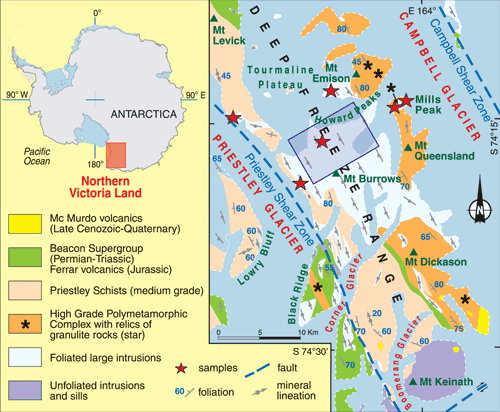
Figure 1. Geological map of the Deep Freeze Range, Northern Victoria Land – Antarctica, showing sample localities. 

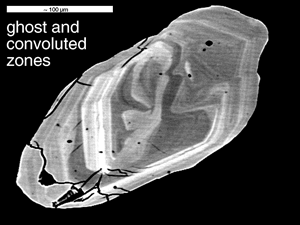
Figure 2. Back-scattered electron/cathodoluminescence images showing secondary structures in the studied zircons. In contrast, a relatively narrow range of initial 176Hf/177Hf ratios has been obtained in distinct zircon populations within each sample. The lack of correlation between Hf ratios and zircon age populations suggests that the Lu-Hf system was left relatively undisturbed, while other elements including U, Th and Pb migrated within the grains. The similar low 176Hf/177Hf ratios in all the samples suggest a common parental derivation from old recycled crust for the different selected intrusives. Figure 4. Chondrite-normalised trace-element
abundances of zircons. The dark field contains the unreset compositions. There appear to be two main processes responsible for the great variety in zircon age signatures, the modification of zircon zonation and trace-element redistribution: 1) pervasive deformation and sub-solidus recrystallisation related to the occurrence of a dextral strike-slip shear zone in this area 2) slow cooling of the pluton, probably associated with new mafic magmatic pulses Contacts: Rosa Maria Bomparola, Bill Griffin, Sue O’Reilly Funded by: Università degli Studi di Siena, Italy
|
| From dunite to lherzolite: tracking refertilisation
of Archean peridotite in Norway
From Dunite..... Dunite quarry at Ekremseter, Western Gneiss Region, Norway, and thin section image of a garnet-free dunite. .....To Lherzolite Garnet peridotite block from a quarry in Gusdal, Western Gneiss Region, Norway. The thin section image is a garnet-rich lherzolite. |
Garnet peridotites are widely distributed across the Proterozoic Western Gneiss Region (WGR) of western Norway and typically occur as discrete zones within larger masses of dunite. Previous work on the WGR peridotites has tended to focus on the garnet peridotites as the most interesting rock type, but this disregards the volumetrically most significant part of the peridotite bodies. The dunites have long been interpreted as retrograded garnet peridotites, based on the close spatial relationship between the two rock types and evidence for retrogression of garnet and clinopyroxene to chlorite and amphibole (also minor phases in some dunites) along the margins of the garnet peridotite bodies. However, analyses carried out at GEMOC, at the Technical University of Trondheim and by A/S Olivin (the company that mines the dunite for refractory material) show that this interpretation is very unlikely. In fact, the bulk of the dunites at the major Almklovdalen locality in the southern WGR are highly refractory and cannot represent retrograded garnet peridotite.
Whole-rock compositions for the garnet peridotites show that they are moderately depleted in most basaltic components but show an overall enrichment in Fe relative to the low-T peridotites typical of cold, melt-depleted lithospheric mantle. This pattern is characteristic of high-T sheared xenoliths and suggests re-enrichment of a depleted precursor. Furthermore, rare earth element patterns for the Almklovdalen garnets are enriched in heavy rare earth elements (REE) but depleted in light REE, similar to garnets from high-T sheared peridotite xenoliths.
Contacts: Eloise Beyer, Sue O’Reilly, Bill Griffin Funded by: ARC, Macquarie University Postgraduate Research Grant, GEMOC |
| Fingerprinting diamonds
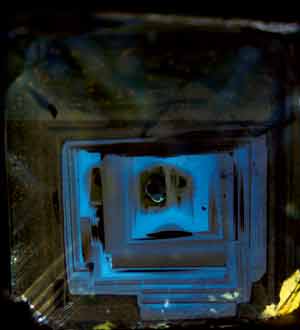
Figure 1. A cathodoluminescence image of the internal
structure of a diamond from Koffiefontein, South Africa, showing growth
zoning. Trace-element variations can be correlated with zonal patterns
imaged by CL.
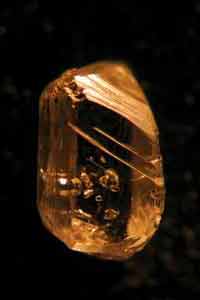
Inclusions in a diamond from Finsch, South Africa. |
The chemical composition of diamond can be expressed very simply as almost 100% carbon. But is there anything that makes each diamond unique? Can we distinguish between diamonds formed from different sources in different parts of the world? Even within a single locality, the diamonds may differ from each other because of variations in the mantle host rock compositions, depth of formation, and conditions of growth. Studying the trace elements in diamonds may provide an answer. Most diamonds, during crystallisation, incorporate minute amounts of trace elements, either in their crystal lattice or as submicroscopic inclusions, and may represent the medium/fluid from which the diamonds grew. Once they are trapped inside the diamond, the inclusions do not react with the environment unless exposed to oxygen and/or high temperatures. Characterisation of the trace-element (especially rare earth element) patterns of diamond has been suggested as a possible means of “fingerprinting” stones from different sources. The question is more than scientifically interesting - it has geopolitical implications. "Conflict diamonds", mined illegally in war zones, are used to launder illicit funds and to finance wars, and represent a major headache for the legitimate diamond industry. The ability to identify the sources of diamonds on the market could help to limit this trade.
The diamonds come from a range of localities including Siberia, Eastern Australia (Wellington and Bingara), Brazil (Juina), Canada (Slave Province), Thailand, and South Africa (Koffiefontein, Finsch, and Premier mines). Fibrous diamonds from Jwaneng and Central Africa are also being studied. Mineral inclusions are used to classify the diamonds into eclogitic, peridotitic and superdeep parageneses, and diamonds of different paragenesis from the same locality are being studied. Preliminary results indicate broad similarities in trace-element patterns (but differences in abundances) of the samples analysed. The patterns of many diamonds, and especially those of fibrous diamonds, strongly resemble those of average carbonatite and average kimberlite (Fig. 2),but the strong negative anomalies for elements such as Zr, Ti and Nb in these patterns are more similar to the carbonatite pattern. This exciting result suggests a genetic link between these mantle melts and diamond genesis. Despite the broad similarities, there appear to be some consistent differences between diamonds of different parageneses, and between diamonds of similar paragenesis from different localities. If these variations prove to be statistically significant, they may offer a possibility of fingerprinting diamonds from different sources, and of unravelling the mechanisms of diamond formation. Contacts: Sonal Rege, Bill Griffin, Sue O'Reilly Funded by: GEMOC, Macquarie University |

|
| TerraneChronTM success keeps soaring
|
GEMOC’s TerraneChron™ is delivering a valuable new tool to the exploration industry. Integrated with our methodology for dating mantle sulfides in situ, it is also providing an additional novel solution to tracking the timing of formation of crust and mantle components in the same lithospheric column. Industry tool TerraneChron™ has been shown to be able to map the tectonic history of complex regions with “uncanny accuracy” according to one of our Industry partners exploring an extensive, difficult and largely unmapped terrain. TerraneChron™ analyses zircon concentrates from defined drainages using three instrumental in situ techniques to provide the zircon ages (U-Pb method), their host rock type (from our trace-element database) and the type of tectonic event that produced the host rock (the Hf isotopic composition defines whether crust recycling and/or mantle input was important). This information yields a synthesis of the tectonic history represented in the drainage area (Publications #251, 261, 288, 289, 291, 300). Unravelling crust-mantle connections Understanding the complexity of continental assembly, breakup and rearrangement requires tracking the timing of events that have affected the crust and mantle components. Important questions include: • Was formation of the crust and the underlying lithospheric mantle contemporaneous? • How long have crust-mantle sections been coupled? GEMOC has also developed a method for measuring Re-Os in situ in mantle sulfides (see Technology Development), thus determining the model ages recorded by each sulfide with an identified petrological spatial relationship. This is a breakthrough in unravelling the timing of significant mantle events that precipitated new sulfides, or interacted with existing ones. Thus TerraneChron™ provides timing and tectonic style information for crustal terranes and the sulfide Re-Os in situ method yields timing and context information for multiple mantle events recorded in single rock types (Publications #267, 268, 290, 292). THE COMBINATION OF THESE TWO NOVEL METHODOLOGIES CAN NOW BE APPLIED TO UNDERSTANDING CRUST-MANTLE RELATIONSHIPS DURING LITHOSPHERE FORMATION AND THROUGH SUBSEQUENT LITHOSPHERE EVOLUTION EVENTS. |
|
|
The lower crust is an important lithospheric
layer, that may integrate the history of crust-mantle interaction through
time. Some of the best direct evidence about this history comes
from the examination of lower-crustal xenoliths, usually granulites,
brought up in volcanic eruptions. In 2002 GEMOC and the China University
of Geosciences (Wuhan) collaborated on integrated U-Pb and Hf-isotope
studies of zircons in such xenoliths from two widely spaced localities
in the North China Craton (Fig. 1): Fuxian
in the northeast, and Henan along the southern margin. The craton
consists of several nuclei; ancient rocks (>3.5 Ga) are known in the
northeastern part, whereas the oldest rocks in the Henan region are ca 2.8
Ga. Figure 1. Mafic granulite, amphibolite and garnet-metagabbro xenoliths in the Paleozoic Fuxian kimberlites (locality 1) contain zircons with an obvious multistage history, which is strikingly revealed in their BSE/CL images (Fig. 2) – older strongly zoned cores are overgrown by wide structureless rims. U-Pb dating using LAM-ICPMS yielded concordant ages ranging from 2620-2430 Ma for the strongly zoned portions, and near-concordant ages of 1927-1852 Ma for rims and structureless grains. One granulite contained two populations of structureless grains, dated at 1927±55 Ma and 600-700 Ma. The interpretation of the U-Pb ages was enhanced by measuring the Hf-isotope ratios of the same grains, using GEMOC’s LAM-MC-ICPMS facility. In each sample zircons with 2620-2430 Ma ages showed no variation in their 176Hf/177Hf ratios (ie their eHf lie on the evolution curves in Fig. 3). This suggests that the spread in ages reflects semicontinuous loss of radiogenic Pb (but no exchange of Hf with the surroundings) during slow cooling of the mafic magmas in the lower crust. In this case the oldest ages are closest to the magmatic intrusion age. In some granulites, the younger zircons have much higher 176Hf/177Hf than the older ones (ie their eHf lie above the evolution curves in Fig. 3). This pattern strongly suggests that they grew from Zr and Hf liberated by breakdown of the older silicate minerals, in which radiogenic 176Hf had grown from 176Lu over the intervening time. In other samples, the younger and older zircons have similar 176Hf/177Hf, and the younger ages thus appear to represent recrystallisation of the older zircons, rather than growth of new zircon. The 2.6 Ga ages in the Fuxian xenoliths are similar to many ages from upper-crustal rocks in the area, and represent a major period of crustal growth in the craton; it appears that mafic magmas were being added to the lower crust during this episode. The 1.8-1.9 Ga ages correspond to the collision between the Eastern and Western Blocks that led to the final assembly of the North China Craton. The growth of metamorphic zircon at ª600 Ma may be related to an asthenospheric upwelling and crustal heating in Neoproterozoic time, which produced a regional disconformity across the North China Craton. Figure 3. Hf-isotope evolution lines (reflecting simple
Pb loss) and data points for zircons from N. China granulite xenoliths. While the Fuxian granulites recorded the expected major crustal events in the NE part of the craton, a greater surprise awaited us in the felsic granulite xenoliths from Mesozoic lamprophyres in Henan (locality 6). LAM-ICPMS dating at GEMOC, and single-grain U-Pb dating in China, combined with Hf-isotope analysis, showed that two granulites crystallised at ca 3.6 Ga (near-concordant upper intercept dates), and grew new, concordant metamorphic zircon at several stages between 2.8 and 1.7 Ga (Fig. 3). A third granulite contained only metamorphic zircons, with an upper-intercept age of 1991±50 Ma and a poorly defined lower intercept age of 830±290 Ma; all lie on the evolution line predicted for simple Pb loss. However, this sample contains two zircons with lower eHf , suggesting an older component. The older group of zircons has 176Hf/177Hf below the mantle evolution line (Fig. 2; eHf ª-5), which indicates derivation by remelting of an older source rock. Whether this source was felsic or mafic, its age must be more than 3.9 Ga, and almost certainly more than 4.1 Ga, similar to the oldest crustal ages known on Earth. What makes this finding extraordinary is that the oldest rocks now exposed in the upper crust of the Henan part of the North China Craton are only ca 2.6 Ga old, and the nearest exposed 3.5 Ga rocks are found over 1000 km to the NE (Fig. 1). 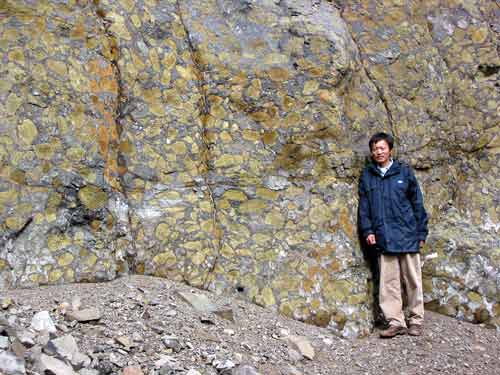
The Henan xenolith data show that parts of the lower crust may be not only more felsic than expected from similar data worldwide, but also much older than the overlying upper crust. It this finding is repeated in many other places, it will affect our ideas on the composition of the crust, and especially on the rates of crustal generation through time. Contacts: Bill Griffin, Sue O’Reilly, Jianping Zheng and Ming Zhang Funded by: ARC, GEMOC, AusAID ACICP, Macquarie University |
| La plume de mon Massif ?
|
The french massif central region (Fig. 1) is an uplifted area of Hercynian (400-250 Ma) metamorphic and granite rocks, originally part of a convergent mountain belt. Alkaline volcanism occurred from the late Tertiary into Quaternary time, bringing abundant mantle and crustal xenoliths to the surface. The uplift, volcanism and high regional heat flow have been attributed to a mantle plume beneath the recently active volcanic areas such as Cantal, Velay and Devès. The plume has been imaged by seismic tomography (Fig. 2), but its existence is still controversial and other suggestions are that the mantle upwelling could be the result of the Alpine orogeny. The penetration of the Alpine root could imply asthenospheric flow and thermal-mechanical erosion of the lithosphere which could be responsible for extension and subsequent Tertiary-Quaternary volcanism. Recent geophysical studies by French geophysicists have shown that the Massif Central is made of two different lithospheric domains separated by a lithospheric fault (Sillon Houiller; Fig. 1). Figure 1. Simplified geological map of
the French Massif Central.
The primary aims of the project are to relate geochemical data for the French peridotites to the available geophysical data in order to answer questions such as: What are the metasomatic agents percolating through the mantle? What is the contribution of the lithospheric mantle to the Tertiary and Quaternary alkaline volcanism? The work so far has focused on spinel-bearing peridotites from two localities, Marais de Limagne (Fig. 3) and Mont-Coupet (Fig. 4), located in Devès volcanic district; both are dated as erupting at 1.9 Ma. Figure 2. Tomographic image beneath Cantal
and Velay volcanic districts, after Granet et al., Bull. Soc. Geol. France,
2000, 171, 149-167: SH = Sillon Houiller.
The lherzolites from Marais de Limagne are inferred to come from deeper levels (higher temperatures) and they are more affected by complex metasomatism than the ones from Mont-Coupet. The mantle beneath Devès volcanic district therefore shows significant heterogeneity between two closely-spaced localities of similar age. Stable isotope analyses (Jean Monnet University) and radiogenic isotope analyses (GEMOC) are starting to provide more information about the metasomatic agent.Contacts: Stephanie Touron, Sue O’Reilly, Jean-Yves Cottin, Gilles Chazot Funded by: ARC Discovery and IREX, Macquarie University, Eurodoc and the French Government Co-tutelle program |
|
|

|
| Hafnium in rutile frees Slave secrets
Figure 1. Chondrite-normalised trace-element patterns of rutile in eclogites and pyroxenites. Element order corresponds to increasing compatibility of the elements in the rutile. Trace-element patterns of eclogitic rutile from the literature are shown for comparison. |
The kimberlites of the Slave province in northern Canada contain abundant, but small (1-3 cm) xenoliths of eclogites, many of which contain diamonds. As part of a collaborative project with Kennecott Canada, GEMOC is carrying out a detailed investigation of eclogite xenoliths from the Lac de Gras kimberlites. We hope to find out when and where they formed, and their spatial relationship to other lithologies in the lithospheric mantle. Many of these samples, including the rutile-bearing varieties, have major and trace-element signatures, eg positive Eu and Sr anomalies, suggesting that an origin as subducted oceanic crust should be considered. Because the samples are so small, and commonly altered, it is difficult to date the eclogites by conventional means. Eclogitic rutile is a major carrier of Hf, and its Hf isotopic composition can be measured in situ, for age determinations and to constrain the nature of the eclogite source. We have used a New Wave/Merchantek LUV266 laser microprobe attached to GEMOC’s Nu Plasma multicollector ICP-MS to measure the Hf-isotope composition of individual rutile grains in polished sections. We also have measured the abundances of Lu and Hf, as well as other trace elements, in the rutile (Fig. 1) and the major minerals (garnet and clinopyroxene) of the eclogites, using a laser microprobe attached to an Agilent 7500 ICPMS (see Technology Development section). These analyses, and the modal abundances of the minerals, have been used to reconstruct the bulk Lu/Hf ratios of the whole rocks. The values we determined are comparable to those obtained in other studies, supporting the validity of our analytical method.
176Hf/177Hf in the rutiles ranges from 0.28156
± 0.00026 to 0.28567 ± 0.00010. Rutile contains very
little Lu, and the variability in Hf isotopic composition is most easily
explained by isotopic equilibration with coexisting high-Lu/Hf phases such
as garnet. If the eclogites resided in the lithospheric mantle above
the closure temperature, the Hf isotopic composition of rutile should reflect
that of the eclogite at the time of entrainment in the kimberlite.
Using the Lu/Hf of the reconstructed whole rocks and 176Hf/177Hf of rutile,
seven of eight samples define an isochron (Fig. 2).
The excluded sample, in contrast to the others, has trace-element abundances
consistent with the loss of partial melt. Figure 2. Lu-Hf isochron diagram. The isochron gives an age of 1.91 ± 0.36 Ga,
with an initial Hf isotopic composition of 0.28062 ± 0.00032
(MSWD = 0.78, assuming 20% uncertainties on the reconstructed whole-rock
176Lu/177Hf). What does the age record? One interpretation
is that the eclogites represent subducted oceanic crust of Proterozoic
age. After its amalgamation at ~2.7 Ga, the Slave Craton was involved
in several collisions along its western and eastern margin (Fig. 3). The isochron age is very close
to the age of eastward oriented subduction that produced the Great Bear
magmatic arc at 1.875 to 1.840 Ga west of the Slave craton, following
collision with the Hottah arc. However, the initial 176Hf/177Hf
is very depleted, and corresponds to the ratio expected in the upper mantle
at ca 3.2 Ga – similar to the age recorded by the Re-Os systematics of
sulfide inclusions in the Slave peridotites (see Research
Highlights 2001). This could suggest isotopic equilibration
between the eclogites and the peridotites, which would make the meaning
of the isochron age questionable. Several other interpretations remain
open, and are being tested by Re-Os analysis of the eclogites.
Figure 3. Structural provinces of northwestern
Canada. Star denotes sample locality . Contacts: Sonja Aulbach, Bill Griffin, Sue O'Reilly Funded by: ARC SPIRT, ARC Discovery, Macquarie University |
| Mantle composition and processes beneath
the Taiwan Strait, SE Asia
Figure 1. Simple tectonomagmatic map of South China and adjacent regions. Red areas mark outcrops of late Cenozoic intraplate basalts. Stars mark localities of mantle xenoliths: yellow, samples studied here; white, samples from other GEMOC projects. Inset: sample localities. |
The evolution of the subcontinental lithospheric mantle (SCLM) is of fundamental importance to understanding the growth and stability of continents and long-term mantle evolution. Studies of mantle xenoliths from continental areas have shown that the SCLM has a complex history of depletion and enrichment, related to multiple episodes of partial melting and metasomatism. Extensive and widespread Cenozoic basaltic volcanism in Eastern China captured abundant mantle xenoliths, which make it possible to evaluate the compositional heterogeneity of the SCLM beneath the region, and the processes that produced it. The region underwent major lithospheric thinning and extension in Miocene time, leading to submergence of the crust. Mantle xenoliths occur in Miocene (~16-8 Ma) intraplate basalts from Taiwan and Penghu Islands, SE China (Fig. 1). The generation of the basalts is generally attributed to Cenozoic lithospheric extension which could have resulted in thermo-mechanical erosion of the basal SCLM by convective upwelling of the asthenosphere. Consequently, during ascent, the extension-induced basalts that are derived mainly from the asthenosphere may tap the SCLM beneath this region. 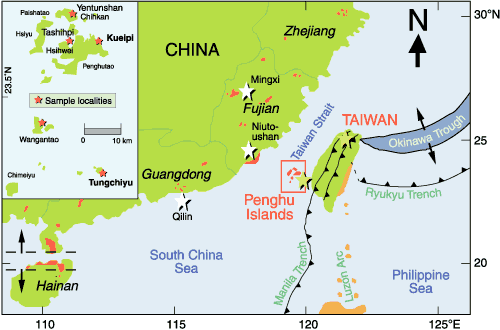
The xenoliths are dominantly spinel peridotites with rare spinel and spinel-garnet pyroxenites and one reported garnet peridotite. The equilibration temperatures of spinel peridotites range from 879°C to 1250°C. Most peridotites have fine to coarse-grained porphyroclastic or equigranular microstructures, and some are foliated. They commonly show textural disequilibrium with clinopyroxene exsolution lamellae in orthopyroxenes, spinel exsolution in clinopyroxenes, and strained clinopyroxene grains coexisting with strain-free clinopyroxene neoblasts. Some orthopyroxenes have cores with high Ca contents, indicating partial equilibration of the rims to lower temperatures. These observations suggest that the peridotites have originated from upwelling of deeper mantle materials. The peridotites show a large range in modal clinopyroxene contents; some have more clinopyroxene (>20%) than most estimated primitive mantle compositions. Rare depleted peridotites contain amphibole and/or apatite. However, the major-element data suggest that some of the lithospheric mantle beneath this region is quite refractory. The Fo contents of olivine in spinel peridotites range from 86.0 to 91.6, but most fall between 90.0 and 91.0; mg# of olivine is correlated with cr# (0.11~0.55) in spinel. Trace-element patterns of clinopyroxene in these peridotites can be divided into three types: depleted, enriched and intermediate. The depleted patterns ((La/Yb)N≈0.1~0.3; (La)N≈0.2~0.7) are typical of unmetasomatised, refractory, lithospheric mantle. The enriched and intermediate ones provide fingerprints of different metasomatic episodes. At least two episodes of metasomatism can be recognized. High La/Yb and low Ti/Eu ratios in clinopyroxenes indicate carbonatitic metasomatism, which the GEMOC database shows to be typical for extensional settings worldwide (Fig.2).The other metasomatic signature is geochemically characteristic of silicate melt interaction. Further work will map the distribution of these two processes with depth. Preliminary in situ Re-Os analysis of sulfides in the mantle peridotites reveals old ages for the original lithospheric mantle formation and suggests that some Proterozoic mantle domains have survived, but may have been subjected to metasomatic re-enrichment during the Miocene extension and thinning in this region.Contacts: Kuo Lung Wang, Sue O'Reilly Funded by: ARC, Macquarie University, National Taiwan University |
| Figure 2. (La/Yb)N vs Ti/Eu ratios of clinopyroxenes from Penghu Islands peridotites and pyroxenites.
|

|
| Waves of fluid invade the mantle beneath
western Victoria
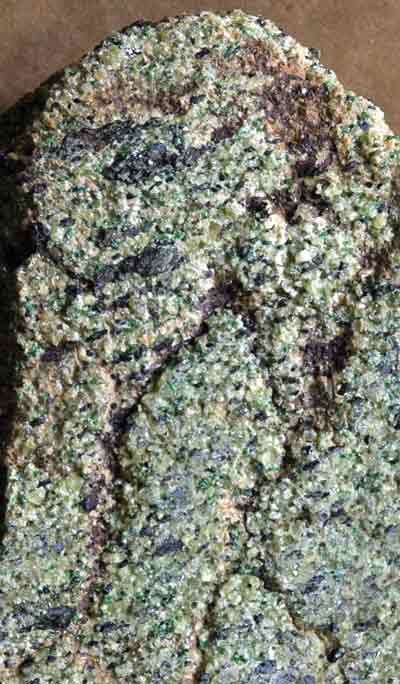
Foliated amphibole- bearing xenolith from Bullenmerri, western Victoria. 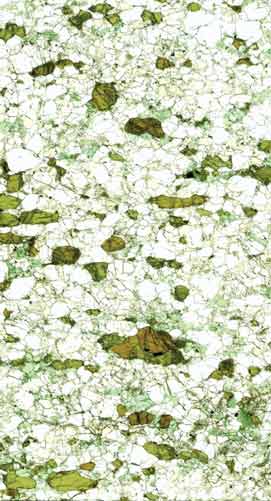
Petrographic section of a foliated, amphibole-bearing spinel peridotite from Gnotuk, western Victoria. |
Metasomatic effects have been widely recognised
and described in mantle samples delivered to the Earth’s surface as xenoliths
in deeply-derived magmas. The thin and shallow lithospheric mantle
beneath western Victoria, sampled by basaltic volcanics, records multiple
and varied episodes of fluid percolation. Modal metasomatism by
the fluids deposited different generations of metasomatic minerals including
amphibole, phlogopite, clinopyroxene and apatite. Cryptic metasomatism
altered the trace-element abundances of phases already present in the
mantle wall-rock by partitioning of elements between the minerals and
the metasomatising fluid, imparting a ‘signature’ characteristic of the
fluid type. Clinopyroxene is the main host phase for trace elements in the (common) mantle assemblage olivine + orthopyroxene + clinopyroxene + spinel, which makes it most important for identifying trace-element signatures of cryptic metasomatic agents. However in modally-metasomatised lithospheric mantle, phases such as amphibole, phlogopite or apatite contain significant parts of the whole-rock trace-element budget, and must be included in attempts to characterise metasomatic agents. Samples from Bullenmerri and Gnotuk, Western Victoria provide a unique opportunity to study the effects of multiple episodes of modal metasomatism on a lithospheric volume. The xenolith suite at these localities contains a diverse range of rock types and assemblages from the garnet- and spinel stability fields, including peridotites, pyroxenites and granulites, some of which contain amphibole ± phlogopite ± apatite. Previous studies of xenoliths from western Victoria have ascribed their features to several metasomatic agents, including silicic- and carbonate-rich types. A selection of amphibole (± apatite) bearing xenoliths was chosen for this study, to further characterise the metasomatic episodes undergone by the lithospheric mantle in western Victoria. 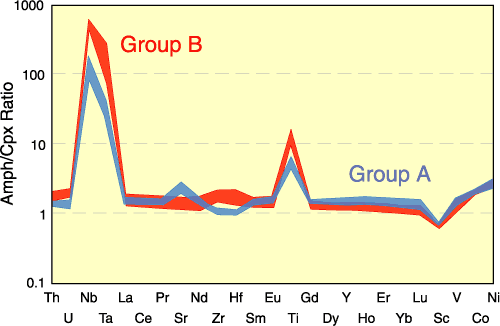
Figure 1. Values of Damph/cpx for western
Victorian xenoliths. The xenoliths in this study can be divided into groups that show differences in geochemical, isotopic, modal, and petrographic features, inferred to reflect differences in metasomatic agent(s). Samples in Group Ahave features consistent with silicate metasomatism, Group B has features consistent with metasomatism by a carbonate-rich fluid (such as a carbonatite), and Group C samples have features overlapping those of groups A and B, although metasomatism by a silicic metasomatising agent with a hydrous component appears likely. Amphibole and clinopyroxene major-and trace-element compositions vary systematically between the groups. In Group A samples, amphibole and clinopyroxene are relatively low in Si, Na and Cr, and high in Al and Ti. In Group B both phases are relatively enriched in Si, Na and Cr, and low in Al and Ti. Distribution of trace elements between coexisting clinopyroxene and amphibole is also found to vary systematically between the groups (Fig. 1).
Amphibole surrounding spinel in a mantle xenolith from Bullenmerri,
western Victoria. Field of view is approx. 3.5 mm. Contacts: Will Powell, Sue O’Reilly, Ming Zhang Funded by: ARC, Macquarie University Postgraduate Research Grant, GEMOC |
| Ore grades correlate with Cu and Fe isotopic
data
Figure 1. Photo
of thin section and diagrams showing the spatial distribution of e56Cu
and e57Fe in chalcopyrite and pyrite. Note the distinct isotopic
signatures of the two different veins and the disseminated mineralisation.
|
Metal isotope studies of the Candelaria
Cu-Au-Fe mine, Chile were carried out as part of a larger investigation
into the isotopic fractionation of Cu and Fe isotopes in hydrothermal
systems. The results of this study are applicable to other Cu-Au-Fe
deposits, a class of deposit in which there is currently considerable
interest. Candelaria (115 Ma old) is the richest of many Cu-Fe-Au deposits hosted by volcanic and volcaniclastic rocks in the Chilean Coastal Cordillera south of Copiapó. Ore occurs as veins, breccias, stringer bodies and replacement bodies in altered rocks within the contact metamorphic aureole of a granite. Several lines of evidence suggest that the ore-bearing fluids had a significant igneous component, probably derived from the granites, but there is also evidence for the circulation of basinal brines. Fluid flow directions are not well constrained, but the major pathway for the mineralising fluids is believed to be the Lar Fault, which crops out in the Candelaria mine pit. 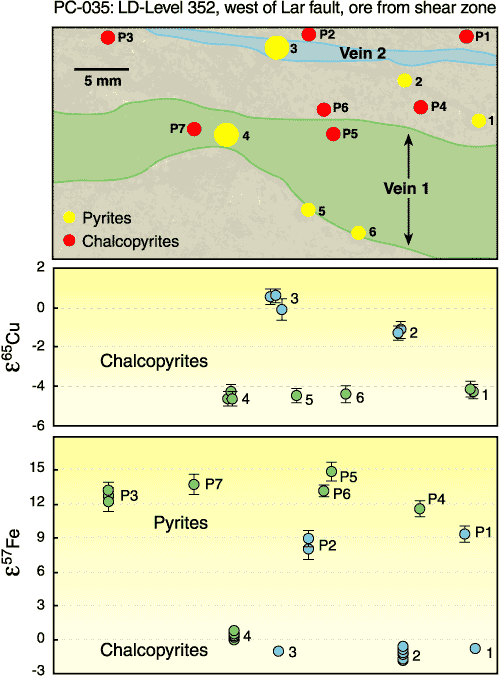
Isotopic compositions of Cu and Fe were obtained in situ using laser ablation multi-collector ICPMS. Thirteen hand-sized samples provided by Phelps Dodge represented a ~700 metre stratigraphic section, but these samples were not obtained from a single drill core, which limits the interpretation of fluid flow. Not all samples are mineralised, although most contained pyrite. The main Candelaria open pit occurs toward the base of the section. Chalcopyrite e65Cu varies from -11 to +6, but most values are between -8 and 0. Half of the samples contain two or more isotopically distinct chalcopyrite populations. In some samples different chalcopyrite veins have different e65Cu values and these veins are isotopically distinct from disseminated chalcopyrite, suggesting numerous mineralisation events (Fig. 1). e57Fe for chalcopyrite varies from -14 to +8, but most e57Fe values are between -7 to 0. In contrast, pyrite e57Fe values show a much larger range, from -24 to +15. The pyrite data also form two distinct groups, with e57Fe between -22 to -12 and -1 to +13 (Fig. 2). These two groups are almost totally mutually exclusive and do not occur systematically throughout the stratigraphic section. Our investigations of other ore deposits indicate that pyrite with low e57Fe is found in relatively low temperature systems (<400°C), such as porphyry related skarns and the McArthur River Zn deposit (see GEMOC Annual Report, 2001). 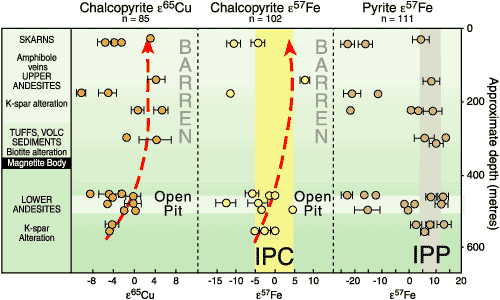
Figure 2. Diagrams showing the variation in e56Cu and e57Fe of chalcopyrite and pyrite through the Candelaria stratigraphic section. Figure 2 shows how e65Cu and e57Fe values vary through the stratigraphic interval. Also shown on this diagram are the e57Fe ranges for chalcopyrite and pyrite porphyry systems (IPC and IPP, respectively). Above the “open pit” the average chalcopyrite e65Cu tends to increase with distance from the ore deposit. The samples that lie on this trend, while containing some sulfide, are essentially unmineralised (i.e. BARREN). Two mineralised samples above the ore deposit do not fit this apparent trend and record low e65Cu values and low e57Fe values. The reason for this correlation is not clear. While we have found low e57Fe in pyrite and chalcopyrite from skarn systems associated with magmatic porphyry deposits, chalcopyrite from these systems tends to have high e65Cu values. Isotopic data from the Open Pit samples may provide some insight into the fluids involved in the generation of the ore deposit. Cu and Fe isotope data for chalcopyrite define a limited range, whereas the Fe isotope data from the pyrites span approximately 35 e57Fe units (Fig. 3). Pyrite from a shear zone to the west of the Lar fault has high, porphyry-like e57Fe, whereas pyrite to the east of the Lar fault has low e57Fe, like pyrite in low temperature systems. This sample also contains pyrite that is isotopically intermediate, whereas the sample in the centre contains both the intermediate and high groups. The presence of pyrite with intermediate e57Fe values is highly suggestive of fluid mixing. We therefore believe that the Candelaria ore system contains two fluid components: one is similar to igneous porphyry systems and the other is similar to low temperature sedimentary systems. Ore-grade samples at Candelaria contain sulfides that have low e65Cu and e57Fe. It appears that metal precipitation away from the main ore zone may have been associated with brines rather than magmatic hydrothermal fluids. 
Figure 3. Variation of chalcopyrite
and pyrite e65Cu and e57Fe within the Candelaria open pit. Note
the variation of pyrite e57Fe from west to east.
Contacts: Stuart Graham, Simon Jackson, Norman Pearson, Bill Griffin Funded by: Industry, Macquarie University, GEMOC |
| Mg isotopes in olivine track fluid flow
in the mantle
|
Magnesium has three naturally occurring stable isotopes, 24Mg (78.99%), 25Mg (10.00%) and 26Mg (11.01%), but little is known about how much the isotopic composition of Mg varies in nature, or why. Recent developments in multi-collector inductively coupled plasma mass spectrometry (MC-ICPMS) have made it possible to measure the isotopic composition of Mg to a precision ten times better than previously possible. This has stimulated interest in how variations in the isotopic composition of Mg reflect geological and biological environments.
During 2002, we have investigated the isotopic variability of Mg in the lithospheric mantle by analysing olivine from peridotite xenoliths and megacrysts from beneath Archean cratons (Siberia, Kaapvaal, Slave), Phanerozoic fold belts (south-eastern Australia) and oceanic islands (Kerguelen Island). Olivine from a dunite at Almklovdalen, Norway (ALM-1; Fo = 92.9), and spinel lherzolite xenoliths from San Carlos (SC-1; Fo = 91.1), Arizona, USA, were selected as potential laser standards, and analysed in solution, relative to SRM980 Mg and other high-purity Mg ICPMS standards. Solutions were introduced into the plasma using a CETAC MCN 6000 to reduce the levels of H2O, CO2, O2 and N2 in the plasma. In situ analysis used New Wave Merchantek LUV266 and LUV213 laser ablation systems attached to GEMOC’s Nu Plasma MC-ICPMS. Mg isotopic compositions are expressed as per mil (‰) deviation from the isotopic composition of SRM980: dnMg = [(nMg/24Mg)sample/(nMg/24Mg)SRM980 – 1] x 1000 Figure 2. Magnesium three-isotope plot (relative
to SRM980) of laser ablation analyses of olivine from peridotite xenoliths
and megacrysts from the lithospheric mantle. The three-isotope plot of the Mg isotope ratios (Fig. 1), shows a linear relationship between SRM980, and the solution analyses of Almklovdalen and San Carlos olivines, and high purity Mg (SPEX). The slope of this line is within error of the Terrestrial Fractionation Curve of Galy et al. (Science, 290, 2000; slope = 0.5163). Replicate analyses of the Almklovdalen olivine gave a precision of 0.20 ‰ (2s) for d26Mg and 0.12 ‰ (2s) for d25Mg. The precision for the San Carlos olivine is greater (0.37 ‰ (2s) for d26Mg) because of grain-to-grain differences. Figure 3. Range of measured d26Mg (relative
to SRM980) of mantle olivine from specified localities. The olivine analyses show significant variations in d26Mg and d25Mg in the lithospheric mantle. The overall range for the analysed samples is 0.90 - 5.40 ‰ 26Mg/24Mg and 0.35 - 2.70 ‰ 25Mg/24Mg. In the three-isotope plot (Fig. 2), the in situ analyses of olivine grains from the lithospheric mantle lie on the Terrestrial Fractionation Curve of Galy et al. (Science, 290, 2000). There is a broad trend from lighter Mg isotopic compositions in more depleted Archean xenoliths to heavier compositions in the Phanerozoic samples from SE Australia and Kerguelen (Fig. 3). Individual grains and samples show variations in d26Mg that are much greater than the external precision determined for ALM-1 (±0.20, 2sd). These heterogeneities suggest that the processes that control Mg isotopic fractionation are preserved on the microscopic scale. 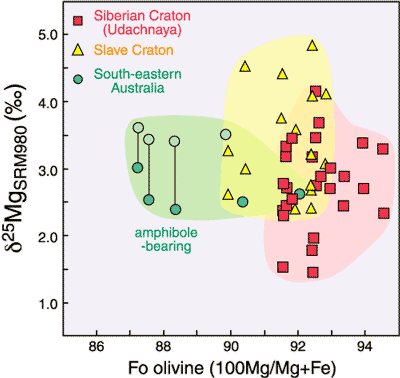
Figure 4. d26Mg versus olivine composition (Fo) for specified samples. Tie-lines show the range in d26Mg measured within individual samples showing modal metasomatism. Samples with petrographic evidence of refertilisation (eg Kaapvaal and Slave sheared peridotites) or modal metasomatism (eg SE Australian amphibole + apatite-bearing xenoliths) show large ranges in dMg values. In the spinel lherzolites from SE Australia, olivine becomes more Fe-rich in the amphibole-bearing samples, and these samples also have the largest variation in dMg (Fig. 4). Sheared peridotite xenoliths from the Kaapvaal and Slave cratons show a shift to heavier dMg values associated with the introduction of fluids with an ‘asthenospheric’ signature. There is a systematic variation between d26Mg, Ca content (related to temperature) and the microstructure of the olivine in sample vr40332a (Fig. 5). The variation in the Mg isotopes of the olivine suggests that parts of the sample have been modified by fluids moving along distinct pathways. Preliminary measurement of Fe isotopes in the olivine in vr50855a indicates a positive correlation between d26Mg and d56Fe. Figure 5. Variation of d26Mg versus Ca
(ppm) in olivine in sample vr40332a.
The change in d26Mg in olivine produced by refertilisation or metasomatism provides a valuable new tool to study these processes in detail. It also helps to understand the history of single olivine grains hosting sulfides that have been dated by the in situ Re-Os isotope method. The data obtained so far on Udachnaya olivine xenocrysts (Publication #292; and Research Highlights 2001) show that sulfides thought to be affected by metasomatism are hosted by grains with higher dMg, as predicted by our other data. Contacts: Norman Pearson, Bill Griffin, Sue O’Reilly, Guillaume Delpech Funded by: ARC, Macquarie University, Industry |
| Trace elements in mantle rocks revisited
–
a warning to modellers |
The upper part of the Earth’s mantle is composed of ultramafic rocks, some of which are restite, ie the material left behind in the mantle when basaltic magma is extracted. Spinel lherzolite is a common ultramafic rock in the mantle at relatively shallow depths (<60 km) and many spinel lherzolites appear to be restite that has become part of the lithosphere. To follow the origin and subsequent evolution of the mantle lithosphere, we need to better understand the origin of these spinel lherzolites, fragments of which are brought to the surface during volcanic eruptions. Incompatible elements, which are transferred to basaltic magma during melting of the mantle, are commonly assumed to image the geochemical “signature” of their mantle source. Important incompatible elements include the high field strength elements (Zr, Hf, Nb, Ta) and the rare earth elements (REE). By determining the distribution of incompatible elements in basalts from various tectonic settings, we should be able to characterize their mantle sources, and mantle-derived xenoliths provide important comparative material as inputs into such models. This, of course, assumes that incompatible elements are not reintroduced into mantle rocks by metasomatic processes after basaltic magmas were removed. During the past year, we have been able to test this assumption using GEMOC's laser microprobe-ICPMS techniques. Are incompatible elements really housed in the major minerals in the uppermost mantle (olivine, orthopyroxene, clinopyroxene, and spinel in order of decreasing abundance)? We have analysed both whole rocks and the individual phases in a suite of spinel lherzolite xenoliths from the southwestern United States, covering different tectonic settings representing different thicknesses and ages of lithosphere. Xenoliths range from those that show no modal evidence of mantle metasomatism (like those from Kilbourne Hole) to some that show significant evidence of metasomatism (Four Corners area of the Colorado Plateau, Grand Canyon, Lunar Crater). None, however, shows geochemical evidence of carbonatite-related metasomatism. 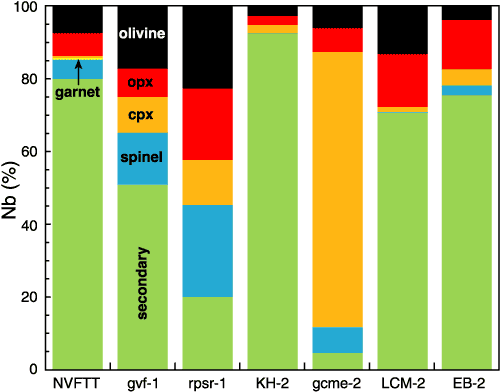
Figure 1. Nb budget in spinel lherzolites from southwestern USA. One major finding was that the least depleted (and hence least restitic) xenoliths have the most depleted incompatible element patterns, suggesting that these fertile rocks have actually experienced the least metasomatism. Like some previous studies, we found that a large fraction of the incompatible elements does not reside in any one of the four major minerals listed above. For instance, mass balance calculations using whole-rock and mineral analyses indicate that up to 90 % of Nb and Ta and 40-90 % of REE must reside in minor, very fine grained secondary phases along grain boundaries or in micro-fractures (Fig. 1). No evidence for melt inclusions was found in any of the rocks. Many of these secondary phases are much smaller than the beam size of the laser probe (≤ 30 microns). Analysis of some of the larger secondary grains around grain boundaries suggests that Ti and Fe oxides and silicates may be important hosts for Nb and Ta and traces of amphibole and sericite may house significant amounts of REE. We also analysed lower crustal xenoliths (garnet granulite) from the Four Corners volcanic field and from Kilbourne Hole (felsic granulite) and eclogites from the Four Corners. As with the spinel lherzolites from the same sites, we found that 30-80% of the incompatible elements in the crustal xenoliths and eclogites must reside in very fine-grained, secondary phases (Fig. 2). 
Figure 2. Thorium budget in mafic
granulites and eclogites from the Navajo Volcanic Field.
Perhaps the most important conclusion from this study is that one cannot a priori assume that incompatible elements reside in major phases in mantle and crustal xenoliths, and hence extreme caution must be exercised in using the incompatible element distributions of these xenoliths to characterize pre-metasomatic mantle or crustal sources. Also, because restitic and fertile mantle xenoliths occur at the same site, it would appear that the lithospheric mantle sources are heterogeneous on a very small scale of centimetres to metres. Contacts: Kent Condie, Sue O'Reilly, Bill Griffin, Norman Pearson Funded by: New Mexico Inst. of Mining and Technology, Macquarie University, GEMOC |

 GEMOC ARC National Key Centre
GEMOC ARC National Key Centre.jpg)
.jpg)
.gif)

